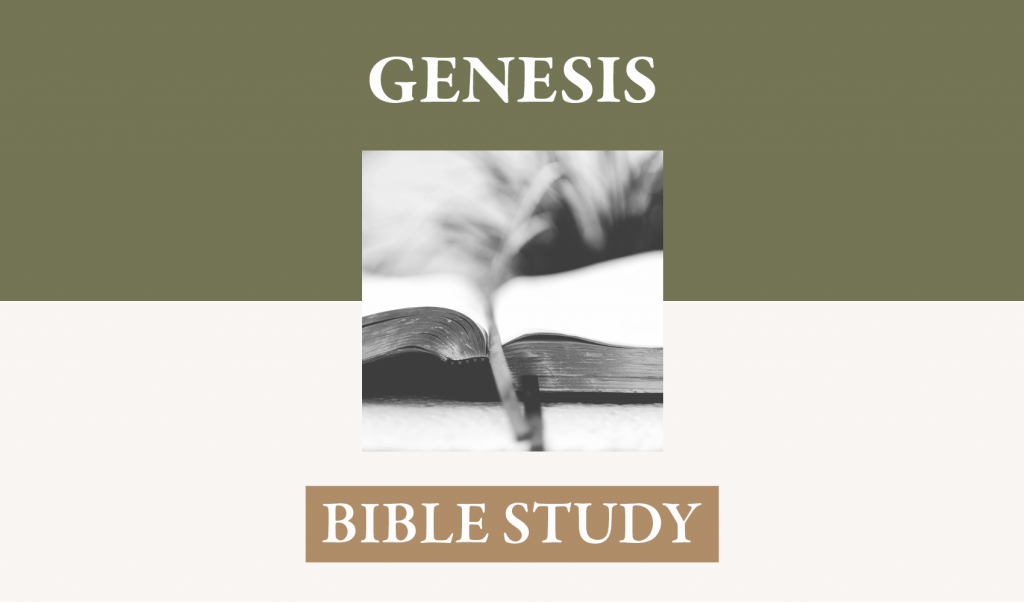The Point: The universe is here because God spoke.
God’s Creation of the World: Genesis 1:1-3,6,9,11,14,20.
[1] In the beginning, God created the heavens and the earth. [2] The earth was without form and void, and darkness was over the face of the deep. And the Spirit of God was hovering over the face of the waters. [3] And God said, "Let there be light," and there was light. [6] And God said, "Let there be an expanse in the midst of the waters, and let it separate the waters from the waters." [9] And God said, "Let the waters under the heavens be gathered together into one place, and let the dry land appear." And it was so. [11] And God said, "Let the earth sprout vegetation, plants yielding seed, and fruit trees bearing fruit in which is their seed, each according to its kind, on the earth." And it was so. [14] And God said, "Let there be lights in the expanse of the heavens to separate the day from the night. And let them be for signs and for seasons, and for days and years, [20] And God said, "Let the waters swarm with swarms of living creatures, and let birds fly above the earth across the expanse of the heavens." [ESV]
[1-3] “It is no accident that God is the subject of the first sentence of the Bible, for this word dominates the whole chapter and catches the eye at every point of the page. It is used some thirty-five times in as many verses of the story. The passage, indeed the Book, is about Him first of all; to read it with any other primary interest is to misread it. In the beginning, God affirms unequivocally the truth laid down elsewhere [e.g., Heb. 11:3] that until God spoke, nothing existed. The meaning of created is best determined from the Old Testament as a whole, where we find that its subject is invariably God, its product may be either things or situations, its companion verbs are chiefly ‘to make’ and ‘to form’ [Gen. 1:26,27; 2:7], and its precise sense varies with its context, which may emphasize either the initial moment of bringing into existence or the patient work of bringing something to perfection. Here in verse 1 created emphasizes the beginning of the process of God’s creating activity. Verse 2 is an expansion of the statement just made in verse 1, and its own two halves are concurrent. It sets the scene, making the earth our vantage point. The somber terms (without form and void, and darkness) of verse 2 throw into relief the mounting glory of the seven days; and if God alone brings form out of formlessness, He alone sustains it. The Hebrew word for without form is used elsewhere to mean, in physical terms, a trackless waste, emptiness, chaos; and metaphorically, what is baseless or futile. The deep refers to the literal ocean. Not in conflict, then, but in evocative activity the Spirit of God was hovering. In the Old Testament the Spirit is a term for God’s outgoing energy, creative and sustaining. The Hebrew verb translated hovering reappears in Deuteronomy 32:11 to describe the eagle’s movements (flutters) in stirring its young into flight; this aspect of intimate contact must be kept in mind throughout the creation story. The Spirit of God is not detached from creation but is intimately involved in God’s creating activity whereby He brings form out of what is without form and void. Indeed the six days now to be described can be viewed as the positive counterpart of the twin negatives without form and void, matching them with form and fullness. The simple phrase And God said [3] precludes some far-reaching errors and stores up a wealth of meaning. These eight specific commands, calling all things into being, leave no room for notions of a universe that is self-existent, or struggled for, or random, or a divine emanation; and the absence of any intermediary implies an extremely rich content for the word said. This may not be at once apparent, for we ourselves know what it is to order things to happen. But our commands, even at their most precise, are mere outlines: they rely on existing materials and agencies to embody them, and the craftsman himself works with what he finds, to produce what he only knows in part. The Creator, on the other hand, in willing an end willed every smallest means to it, His thought shaping itself exactly to the least cell and atom, and His creative word wholly meaningful. One might almost express this immediacy of knowledge by saying that He knows each mode of created existence by experience – only experience is too weak a word: you know it altogether [Ps. 139:4]. The New Testament reveals what is already latent here when it calls the Son and Word of God the firstborn of all creation. For by him all things were created, in heaven and on earth … and in him all things hold together [Col. 1:15-17]. Light has lent its name to all that is life-giving [John 1:4], truth-giving [2 Cor. 4:6], gladdening [Ecc. 11:7] and pure [1 John 1:5-7], appropriately marks the first step from chaos to order; and as it here precedes the sun, so in the final vision it outlasts it [Rev. 22:5].” [Kidner, pp. 43-47].
[6] “The second separation of creation is the division in the waters. God formed an expanse to create a boundary, giving structure to the upper and lower waters. The expanse is the atmosphere that distinguishes the surface waters of the earth from the atmospheric waters or clouds. The atmosphere then is depicted as a canopy or dome spread out over the earth. There is no indication, however, that the author conceived of it as a solid mass, a firmament that supported a body of waters above it. The expanse is considered part of the heavens and is named Heaven or Sky. The theological significance of God’s creation of the skies is the clarification that God alone rules the powers of the heavens. The passage therefore asserts that the heavens and their celestial inhabitants are merely instruments to serve God and His earthly creatures; they are not autonomous authorities.” [Matthews, pp. 150-151].
[9] “The third day concerns the surface of the earth: the waters are gathered into seas, thereby distinguishing the land masses, and the earth yields green vegetation. God’s approval for the work of the second day was delayed until the third, when the final separation of the waters was achieved. This finished the three separations of days one through three, which together differentiate the spheres of time and space where life exists. The consequence of the three days is the productivity of the earth that yields its vegetation. God’s gathering and appointment of the waters show that they too are under His dominion. The seas are not independent forces to be feared and worshiped but creations that respond to the direct commands of God. He exerted authority as He named the dry ground earth and the waters seas, assigning them their place and function [10].” [Matthews, p. 151].
[11] “Unlike the first two days of creation, the third day includes a second act of creation. After the appearance of the land masses, God creates vegetation upon the land. This is the climax of the first grouping of days, where for the first time the earth becomes productive. The presence of vegetation prepares the way for the life systems to follow by providing the diet for animal and human life [29-30]. For the first time God’s creative decree is indirect. The land is commanded to produce vegetation. The land by itself, of course, does not produce vegetation; rather God enables the land to do so by His creative word. The vegetation is of two kinds, expressed in general categories: (1) plants producing seed and (2) fruit trees whose fruit possess seeds. Here is the first occurrence of the term seed, which takes on all-important thematic-theological significance in Genesis. It most often has the metaphorical meaning “offspring” and speaks of the children of an individual or family. Here it is enough to observe that the seed of plants and fruit trees is inextricably associated with its “parent,” an assumption that is consequential for understanding the outworking of God’s covenant blessing for the appointed lineage. The vegetation, like the waters, is given prescribed boundaries: they reproduce according to its kind. Creation and procreation according to kind indicates that God has established parameters for creation. But the term is never used of humanity, showing that we are a unique order of creation.” [Matthews, pp. 152-153].
[14] “The fourth day introduces the second group of three days that depict the filling of the universe with movement and life. On this day the luminaries are created and placed in the heavens, paralleling light decreed on the first day. The importance of this day’s events is indicated by the lengthy description, repetition, and place in the literary arrangement of the days. It is second only to the sixth day in detail, and it stands in the middle of the seven-day arrangement. The redundancy of the verse can be attributed to the inverted order that has been noticed in the passage: the commands of verses 14-15 are fulfilled in their reverse order in verses 17-18, and the creation of the sun and moon in verse 16 stands as the centerpiece. The description of the celestial bodies is based upon a human view of the planets from the earth. The narrative stresses their function as servants, subordinate to the interests of the earth. They are to differentiate day and night and to distinguish the seasons, days, and years.” [Matthews, pp. 153-154].
[20] “The fifth day concerns the filling of the waters and the skies. It parallels the second day and the creation of the expanse that separates the waters from the atmosphere. A distinctive feature of the fifth day is the first recorded blessing [22] in the Bible. The fifth and sixth days that concern the creation of living things include God’s benevolent enablement of all life forms to procreate. The creatures are classified according to their dwelling, whether sea or sky. The living creatures, like the vegetation before [11-12], are created according to their kinds [21, 24-25]. Inherently, the created order possesses divinely imposed limitations that establish self-maintained and governed systematic categories. Moreover, God blessed these creatures by enabling them to procreate, indicating again His superior position. This special endowment for living things comes only from God since His word alone brings life. This is the first occasion of a blessing, and it is the theological keyword linking the history of the cosmos and of humanity with the promises to the patriarchs. Genesis shows that God has a blessing for all living creatures as a creation ordinance [1:22,28], but the blessing for the nations will be realized only by those who bless Abraham and his seed [12:1-3]. It is commonplace in the Old Testament for divine blessing to favor the recipient with many descendants and material prosperity. A blessing presupposes a relationship between God and the persons blessed. This blessing indicates that the creatures are in a favored position before the Lord. Here at creation, by this simple dictum, God provides these creatures with the security of a continued existence. The animal world is valued by God and is placed under the caretaking of humans [1:26-28]. The fifth day was also deemed good since it reversed the empty earth.” [Matthews, pp. 155-159].
[24] “The final day of the creation week is the most significant of the six. More space and detail are given to its creative events than to the previous five. As with the third day, there are two creative acts on the final day of the second grouping: land animals [24-25] and human life [26-28]. The dry ground and vegetation were created on the third day, and this sixth day corresponds to it by the creation of animal and man to populate the land and feed on its herbage. As with the creation of vegetation, the land mediates the command of God to produce land creatures. Like the sea creatures in verse 20, these are identified as living creatures. As with the fish and fowl [20-22], God set reproductive parameters (according to their kinds) for these creatures. The text emphasizes that within the animal world there were limitations for each group [25].” [Matthews, pp. 159-160].
God’s Creation of Humans: Genesis 1:26-27
[26] Then God said, "Let us make man in our image, after our likeness. And let them have dominion over the fish of the sea and over the birds of the heavens and over the livestock and over all the earth and over every creeping thing that creeps on the earth." [27] So God created man in his own image, in the image of God he created him; male and female he created them.
[26-27] “In both the opening chapters of Genesis man is portrayed as in nature and over it, continuous with it and discontinuous. He shares the sixth day with other creatures, is made of dust as they are, feeds as they feed and reproduces with a blessing similar to theirs; so he can well be studied partly through the study of them: they are half his context. But the stress falls on his distinctness. Let us make stands in tacit contrast with Let the earth bring forth [24]; the note of self-communing and the impressive plural proclaim it a momentous step. Vis-à-vis the animals man is set apart by his office and still more by his nature; but his crowning glory is his relation to God. The terms, in our image, after our likeness, are characteristically bold. If image seems too pictorial a word, there is the rest of Scripture to control it; but at a single stroke it imprints on the mind the central truth about us. The words image and likeness reinforce one another: there is no ‘and’ between the phrases, and Scripture does not use them as technically distinct expressions. After the Fall, man is still said to be in God’s image [Gen. 9:6] and likeness [James 3:9]; nonetheless he requires to be renewed in knowledge after the image of its creator [Col. 3:10]. This living creature is an expression or transcription of the eternal, incorporeal creator in terms of temporal, bodily, creaturely existence. Likeness in this sense survived the Fall, since it is structural. As long as we are human we are, by definition, in the image of God. But spiritual likeness can be present only where God and man are in fellowship; hence the Fall destroyed it, and our redemption recreates and perfects it. The dominion over all creatures is not the content but the consequence of the divine image. James 3:7-8 points out that we still largely exercise it – with a fatal exception. Hebrews 2:6-10 and 1 Corinthians 15:27-28 speak of its full reclamation by Jesus, and 1 Corinthians 6:3 promises the exalting of redeemed man above angels. In sad contrast, our human record of exploiting what is at our mercy proves the unfitness of fallen beings to govern. The words male and female, coming at this juncture, have far-reaching implications, as Jesus made plain when He coupled them with 2:24 to make the two sayings the twin pillars of marriage [Mark 10:6-9]. To define humanity as bisexual is to make each partner the complement of the other, and to anticipate the New Testament doctrine of the sexes’ spiritual equality.” [Kidner, pp. 50-52].
“So what does it mean to be made in God’s image? One thing it means is that men and women possess the attributes of personality, as God Himself does, but as the animals, plants, and matter do not. To have personality one must possess knowledge, feelings, and a will. This God has, and so do we. We can say that animals possess a certain kind of personality. But an animal does not reason as men do; it only reacts to certain problems or stimuli. It does not create; it only conforms to certain behavior patterns, even in as elaborate a pattern as constructing a nest, hive, or dam. It does not love; it only reproduces. It does not worship. Personality, in the sense we are speaking of it here, is something that links man to God but does not link either man or God to the rest of creation. A second element that is involved in man’s being created in the image of God is morality. This includes the two further elements of freedom and responsibility. To be sure, the freedom men and women possess is not absolute. Even in the beginning the first man, Adam, and the first woman, Eve, were not autonomous. They were creatures and were responsible for acknowledging this by their obedience in the matter of the tree of the knowledge of good and evil. Since the fall that freedom has been further restricted so that, as Augustine said, the original “able not to sin” has become “not able not to sin.” Still there is a limited freedom for man and women even in their fallen state, and with that there is also moral responsibility. It is relevant to the matter of morality that, when the sanctification of the believer is spoken of as being renewed in knowledge after the image of its creator [Col. 3:10] or conformed to the image of his Son [Rom. 8:29], it is the moral righteousness of the individual that is most in view, though of course this may also refer to the perfection of personality in ways we do not as yet understand fully. The third element involved in man’s being made in God’s image is spirituality, meaning that man is made for communion with God, who is Spirit [John 4:24], and that this communion is intended to be eternal as God is eternal. Although man shares a body with such forms of life as plants or flowers and a world with animals, only he possesses a spirit. It is on the level of the spirit that he is aware of God and communes with Him. Here lies our true worth. We are made in God’s image and are therefore valuable to God and others. God loves men and women, as He does not and cannot love the animals, plants, or inanimate matter. Moreover, He feels for them, identifies with them in Christ, grieves for them, and even intervenes in history to make individual men and women into all that He has determined they should be.” [Boice, pp. 90-93].
Questions for Discussion:
1. What does it mean to you personally that God is the Creator and Sustainer of the heavens and the earth?
2. How was the creation of man different from all others parts of creation. What does this tell you about the God-designed purpose of male and female?
3. What does it mean for man to be made in God’s image and likeness?
4. What does 1:27 and Jesus’ use of that verse and 2:24 in describing marriage [Mark 10:6-9] tell you about God’s view of the current “same-sex” marriage movement?
References:
Genesis, volume 1, James Boice, Baker.
Genesis, volume 1, Kenneth Mathews, NAC, Broadman.
Genesis, Derek Kidner, Inter Varsity Press.





















